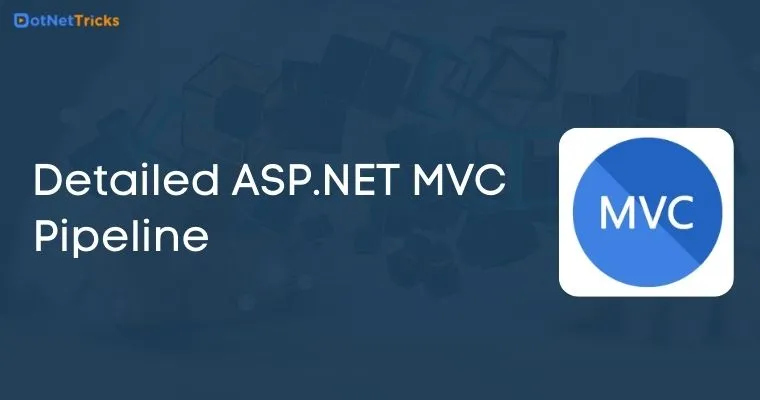Detailed ASP.NET MVC Pipeline
ASP.NET MVC is an open source framework built on the top of Microsoft .NET Framework to develop the web application that enables a clean separation of code. ASP.NET MVC framework is the most customizable and extensible platform shipped by Microsoft. In this article, you will learn the detailed pipeline of ASP.NET MVC.
Routing
Routing is the first step in ASP.NET MVC pipeline. typically, it is a pattern matching system that matches the incoming request to the registered URL patterns in the Route Table.
The UrlRoutingModule(System.Web.Routing.UrlRoutingModule) is a class which matches an incoming HTTP request to a registered route pattern in the RouteTable(System.Web.Routing.RouteTable).
When ASP.NET MVC application starts at first time, it registers one or more patterns to the RouteTable to tell the routing system what to do with any requests that match these patterns. An application has only one RouteTable and this is setup in the Application_Start event of Global.asax of the application.
public class RouteConfig
{
public static void RegisterRoutes(RouteCollection routes)
{
routes.IgnoreRoute("{resource}.axd/{*pathInfo}");
routes.MapRoute(
name: "Default",
url: "{controller}/{action}/{id}",
defaults: new { controller = "Home", action = "Index", id = UrlParameter.Optional }
);
}
}
protected void Application_Start()
{
//Other code is removed for clarity
RouteConfig.RegisterRoutes(RouteTable.Routes);
}
When the UrlRoutingModule finds a matching route within RouteCollection (RouteTable.Routes), it retrieves the IRouteHandler(System.Web.Mvc.IRouteHandler) instance(default is System.Web.MvcRouteHandler) for that route. From the route handler, the module gets an IHttpHandler(System.Web.IHttpHandler) instance(default is System.Web.MvcHandler).
public interface IRouteHandler
{
IHttpHandler GetHttpHandler(RequestContext requestContext);
}

Controller Initialization
The MvcHandler initiates the real processing inside ASP.NET MVC pipeline by using ProcessRequest method. This method uses the IControllerFactory instance (default is System.Web.Mvc.DefaultControllerFactory) to create corresponding controller.
protected internal virtual void ProcessRequest(HttpContextBase httpContext)
{
SecurityUtil.ProcessInApplicationTrust(delegate {
IController controller;
IControllerFactory factory;
this.ProcessRequestInit(httpContext, out controller, out factory);
try
{
controller.Execute(this.RequestContext);
}
finally
{
factory.ReleaseController(controller);
}
});
}
Action Execution
When the controller is initialized, the controller calls its own InvokeAction() method by passing the details of the chosen action method. This is handled by the IActionInvoker.
public virtual bool InvokeAction(ControllerContext controllerContext, string actionName)
After chosen of appropriate action method, model binders(default is System.Web.Mvc.DefaultModelBinder) retrieves the data from incoming HTTP request and do the data type conversion, data validation such as required or date format etc. and also take care of input values mapping to that action method parameters.
Authentication Filter was introduced with ASP.NET MVC5 that run prior to authorization filter. It is used to authenticate a user. Authentication filter process user credentials in the request and provide a corresponding principal. Prior to ASP.NET MVC5, you use authorization filter for authentication and authorization to a user.
By default, Authenticate attribute is used to perform Authentication. You can easily create your own custom authentication filter by implementing IAuthenticationFilter.
Authorization filter allow you to perform authorization process for an authenticated user. For example, Role based authorization for users to access resources.
By default, Authorize attribute is used to perform authorization. You can also make your own custom authorization filter by implementing IAuthorizationFilter.
Action filters are executed before(OnActionExecuting) and after(OnActionExecuted) an action is executed. IActionFilter interface provides you two methods OnActionExecuting and OnActionExecuted methods which will be executed before and after an action gets executed respectively. You can also make your own custom ActionFilters filter by implementing IActionFilter. For more about filters refer this article Understanding ASP.NET MVC Filters and Attributes
When action is executed, it process the user inputs with the help of model (Business Model or Data Model) and prepare Action Result.
Result Execution
Result filters are executed before(OnResultnExecuting) and after(OnResultExecuted) the ActionResult is executed. IResultFilter interface provides you two methods OnResultExecuting and OnResultExecuted methods which will be executed before and after an ActionResult gets executed respectively. You can also make your own custom ResultFilters filter by implementing IResultFilter.
Action Result is prepared by performing operations on user inputs with the help of BAL or DAL. The Action Result type can be ViewResult, PartialViewResult, RedirectToRouteResult, RedirectResult, ContentResult, JsonResult, FileResult and EmptyResult.
Various Result type provided by the ASP.NET MVC can be categorized into two category- ViewResult type and NonViewResult type. The Result type which renders and returns an HTML page to the browser, falls into ViewResult category and other result type which returns only data either in text format, binary format or a JSON format, falls into NonViewResult category.
View Initialization and Rendering
ViewResult type i.e. view and partial view are represented by IView(System.Web.Mvc.IView) interface and rendered by the appropriate View Engine.
public interface IView { void Render(ViewContext viewContext, TextWriter writer); }This process is handled by IViewEngine(System.Web.Mvc.IViewEngine) interface of the view engine. By default ASP.NET MVC provides WebForm and Razor view engines. You can also create your custom engine by using IViewEngine interface and can registered your custom view engine in to your Asp.Net MVC application as shown below:
protected void Application_Start() { //Remove All View Engine including Webform and Razor ViewEngines.Engines.Clear(); //Register Your Custom View Engine ViewEngines.Engines.Add(new CustomViewEngine()); //Other code is removed for clarity }Html Helpers are used to write input fields, create links based on the routes, AJAX-enabled forms, links and much more. Html Helpers are extension methods of the HtmlHelper class and can be further extended very easily. In more complex scenario, it might render a form with client side validation with the help of JavaScript or jQuery.
What do you think?
I hope you will enjoy the ASP.NET MVC pipeline while extending ASP.NET MVC features. I would like to have feedback from my blog readers. Your valuable feedback, question, or comments about this article are always welcome.





